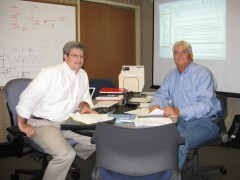In this issue:
- Directors’ Message: TDL Institutional Repositories
- TDL Spotlight: TxLOR Milestone
- Thank you to TDL trainers
- TDL upgrades TDL Repository to Dspace 1.7.2
- TDL Member Board to meet in September
- Tech Teams Update
- New resources available for TDL “beginners”
Directors’ Message: TDL Institutional Repositories
Dear TDL colleagues,

TDL co-directors Mark McFarland and John Leggett
One of the most important services that TDL provides members is the ability to create institutional repositories that collect, curate, and disseminate scholarly and other materials online. The TDL hosts customized DSpace repositories for members and provides training and support in using the software.
TDL members are already doing exciting things with their TDL-hosted DSpace repositories – using them for special collections of photos and bibliographic materials, for instance, as well as electronic theses and dissertations. Additionally, the TDL has worked with UT San Antonio (with funding from THECB And the UT System Office of Health Affairs) to create a statewide learning object repository using DSpace (see story).
Repositories are also a vital resource for collecting and archiving the scholarly output of faculty members and researchers at the institution. While it is sometimes a challenge to generate buy-in from faculty members to deposit their research, repository librarians at a number of schools are finding success in their outreach efforts.
The results are collections of important work – some of it previously unpublished — that might not otherwise be widely accessible through the library, or accessible at all.
Collecting these materials also builds the reputation of the library as a provider of vital information and publishing services to university faculty and promotes the scholarly output of the campus.
As the TDL technical staff continues its project to upgrade all our member repositories to the latest version of DSpace (see story), we encourage our members to continue reaching out to academic departments, institutes, and centers on their campuses to encourage faculty to deposit their work in their institutional repositories.
Sincerely,
Mark McFarland & John J. Leggett
TDL Co-directors
TDL Spotlight: TxLOR reaches beta release milestone
 The TxLOR project has entered a new phase of development this month, as investigators at UT San Antonio release a beta version of the software for testing and feedback.
The TxLOR project has entered a new phase of development this month, as investigators at UT San Antonio release a beta version of the software for testing and feedback.
The Texas Learning Object Repository (TxLOR) is a project to create a statewide system which stores and disseminates high-quality digital learning materials used in higher education instruction across both academic and health institutions. The project, which is led by a team at UT San Antonio, is funded by the Texas Higher Education Coordinating Board (THECB) and the UT System Office of Health Affairs. The Texas Digital Library has provided software development services on the project for several years.
According to Michael Anderson, Director of Online Learning at UT San Antonio, TxLOR will be made accessible to a small group of testers and then to a wider user group over the next several weeks. The beta group will report software bugs and proposed enhancements back to UT San Antonio and the TDL, as well as review and provide feedback on documentation. After any detected bugs are fixed by TDL developers, the TxLOR team will release the repository to full production.
History of the project
The project got its start after THECB and the UT System Office of Health Affairs separately approached what was then UT TeleCampus with similar needs for a tool that could house reusable learning objects in an easily accessible fashion.
Both organizations had been funding course development and redesigns and wanted to make the results of these projects widely available. Additionally, they wanted to be able to keep track of the projects they were funding in order to eliminate duplication.
The academic courses funded by THECB and medical education courses sponsored by the Office of Health Affairs had distinct needs, particularly for metadata creation and maintaining privacy.
UT TeleCampus suggested a joint project to create a statewide learning object repository using open-source DSpace software that would be flexible enough to meet the differing needs of the academic and medical education communities. The project later transferred to the team at UT San Antonio.
Customizable institutional workflows
One challenge of creating a usable repository for TxLOR has been creating configurable workflows for each institution. The TDL’s recent software development efforts with TxLOR have focused on creating these customizable workflows.
In the beta version released this month, for instance, an “institutional administrator” at each TxLOR institution can create multiple customized workflows for different classes of submitters or objects. Any object may go through several approval steps before finally being published to the online repository. Additionally, institutions will have the capability to limit access to learning objects if they choose.
Next steps: After the beta
After beta testing is complete and any bug fixes are resolved, the TxLOR team will recruit interested institutions to use the repository and build a sustainable funding model. They will also set up an informational website with documentation about the system.
Anderson believes there is significant interest in having a place to publish learning objects, as attitudes toward “open access” continue to evolve.
“There are an increasing number of faculty members who support the idea of open educational resources,” Anderson said. “They see the success of MIT’s OpenCourseWare and similar initiatives from other universities.”
Thank you Spring & Summer 2011 trainers!
 The Texas Digital Library would like to thank all the faculty and staff from TDL member institutions who traveled to Waco or Austin during the spring and summer to lead courses for the TDL Training Program.
The Texas Digital Library would like to thank all the faculty and staff from TDL member institutions who traveled to Waco or Austin during the spring and summer to lead courses for the TDL Training Program.
Recognizing that the fastest way to become proficient at something is to teach it, the TDL training program strives to create campus-level experts by giving users the opportunity to prepare and lead training classes. The TDL relies on its users to make this model successful and is appreciative of their exceptional efforts at making the TDL work for all its members.
Volunteer trainers for Spring and Summer 2011 included the following people:
- Lance Grigsby (Baylor)
- Amanda Harlan (Baylor)
- Jeanne Hazzard (Texas State)
- Holly Mercer (Texas A&M)
- Kristi Park (TDL)
- Amy Rushing (UT Austin)
- Karen Savage (Baylor)
- Ryan Steans (TDL)
- Matthew Zimmerman (UT Southwestnern Medical Center)
Special thanks to Amy Alexander of Baylor University for providing logistical support at Baylor’s training facilities.
For more information about the TDL training program, please visit http://main.tdl.org/training/.
TDL Repository upgraded to DSpace 1.7.2, member repositories to follow
 Last month, the Texas Digital Library production team began a project to upgrade all TDL-hosted institutional repositories to DSpace 1.7.2, the latest version of DSpace.
Last month, the Texas Digital Library production team began a project to upgrade all TDL-hosted institutional repositories to DSpace 1.7.2, the latest version of DSpace.
The team successfully completed the upgrade of the TDL Repository, which contains the TDL’s Federated ETD Collection, in August. The upgrade included all customizations to TDL repositories, such as theming and Shibboleth authentication integration.
With the TDL Repository upgrade complete, the team has turned its attention to TDL member institutional repositories. The TDL will be communicating with repository managers about the specifics of the upgrade rollout. Generally speaking, however, the process will include the following steps.
1. TDL staff will create a “staging” version of DSpace 1.7.2 for each member institution that will include all the data in each current repository.
2. Once the staging version is running, local repository managers and their staff will be asked to thoroughly test the staging repository.
3. When the repository manager notifies TDL that the institution is satisfied with the staging version, that institution will be put in a queue to upgrade the production instance of the repository. TDL will not upgrade the production instance until authorized by the local institution to do so.
About DSpace 1.7.2
Since TDL is currently running DSpace 1.5.2, this upgrade will cover two major releases of the repository software. The new DSpace will include performance improvements and bug fixes as well as some exciting new features, including:
- Enhanced statistics (including item-level statistics)
- Batch metadata editing capability
- Delegated administration of Communities and Collections
- Embargo functionality
- Improved Google Scholar metadata exposure
- A Curation System for building and running tasks that facilitate curation of repository items
Some of these features are ones that a repository manager can deploy in the user interface. Others require backend configuration by the TDL system administration staff. Details about custom configuration of DSpace installations will be provided to repository managers.
TDL is excited about bringing these new features and improvements to members. For more information about DSpace 1.7.2, please visit the DSpace website or contact the TDL Program Coordinator at info@tdl.org.
TDL Member Board to meet in September, elect Governing Board members
New Bylaws approved by the TDL Governing Board last spring create a new body within the organization called the TDL Member Board, which is made up of the library directors of all TDL member institutions.
This new body will meet for the first time in the fall during the TCAL Annual Meeting, which takes place September 26-27 in Austin.
The Member Board exists to represent the interests of the full TDL membership and will meet at least once a year to discuss the business of the TDL.
Among other business to be conducted at the upcoming fall meeting, the group will elect three at-large members of the Governing Board who will join the four permanent, founding members. The newly constituted Governing Board will also convene during TCAL.
For more information about governance and organizational changes to TDL beginning in September, please visit the Governance section of the TDL website at http://main.tdl.org/members/governance.
Tech Teams Update
 The Tech Teams Update highlights the work of the TDL technical staff, which is divided into three groups: a software development team, a Production team, and a first-line Support team.
The Tech Teams Update highlights the work of the TDL technical staff, which is divided into three groups: a software development team, a Production team, and a first-line Support team.
Software Development Team
- The software development team completed several months of work on the Texas Learning Object Repository (TxLOR) in preparation for the beta release of the software. (See story on page 2).
- During the weeks of TxLOR beta testing, the team will focus on fixing a bug in the Vireo ETD Management student interface related to the birth year field. Additionally, the team is improving Vireo to produce enhanced error logs.
- The TDL production team completed the upgrade of the TDL Repository to DSpace 1.7.2 and continues work to upgrade all TDL-hosted repositories to the latest version of DSpace (see story above).
- The ICM team also assisted with website support issues and second-level support issues escalated from the Helpdesk.
- The Support team responded to help requests as they came through the TDL Helpdesk.
Production Team
- The TDL production team completed the upgrade of the TDL Repository to DSpace 1.7.2 and continues work to upgrade all TDL-hosted repositories to the latest version of DSpace (see story above).
- The ICM team also assisted with website support issues and second-level support issues escalated from the Helpdesk.
Support Team
- The Support team responded to help requests as they came through the TDL Helpdesk.
New website documentation for beginning users of TDL services
 The TDL website has a new resource for librarians and faculty users who are just getting started with TDL’s faculty communication services.
The TDL website has a new resource for librarians and faculty users who are just getting started with TDL’s faculty communication services.
New “5 Steps” instructions give new users basic information about setting up and using the following TDL faculty communication services:
Librarians may find the documentation useful in helping faculty members prepare for, create, and set up new services. The documentation also points users to more extensive documentation in the TDL Wiki and elsewhere on the web.
The “5 Steps” documentation can be found on the website wherever the “1-2-3” graphic appears (see above left). It is also available in printable format on the Member Resources page.
